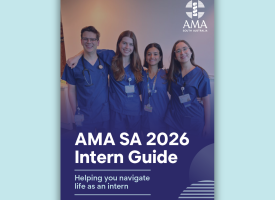AMA Vice-President Dr Chris Moy on future of general practice on ABC Adelaide
Transcript: AMA Vice President Chris Moy on ABC radio Adelaide, 12 May 2022
Subject: Crisis with general practice
NIKOLAI BEIHARZ: One of the other things that you've been sending us many texts about and giving us a lot of calls as well over the course of the morning is this issue of bulk billing, and whether or not we're seeing a trend away from bulk billing. Dr Chris Moy is the Vice-President of the Federal AMA and joins us. Good morning, Dr Moy.
CHRIS MOY: Good morning, guys.
NIKOLAI BEIHARZ: Are we starting - is it a trend? Are there fewer GPs bulk billing now?
CHRIS MOY: I think it is reaching that critical breaking point. The history of the Medicare rebate is that it was, back when it first designed with the Labor Party at that stage, it was meant to assist payment when you saw doctor - and it was meant to cover, essentially, 85 per cent of the agreed fee to see your doctor.
With bulk-billing - where there's no gap [to pay] as a safety net for people that couldn't pay - which is understandable, what's happened over time is essentially because of freezes over time, and that's for both parties, Labor and Liberal, so you can blame both of them. Essentially, these freezes have actually eroded the actual Medicare rebate. So now it's essentially half, or less than half what it should've been if it'd gone up with - even close to inflation.
Now the issue with that is it's left it in a position where the average Medicare rebate for your consultation - your standard consultation where you go see your doctor for, you know, between five and 20 minutes - it's essentially now $38, which is equivalent to a haircut, a men's haircut - probably less, actually. But the problem now is that the - if somebody bulk bills it, there's a consequence.
So, there's two ways it can go. There's a consequence in terms of this because everybody talks about this bulk billing rate which is, now, unfortunately, favouring essentially, faster practices - because they've still got their costs, they've got to pay for their insurance, their rent and obviously their staff. What'll happen is, they've got a choice of either going to a unit cost where they go through faster and spend less time with patients. But that has consequences, which I think now you can see, which are firstly, either there are gaps, number one, which are going to get bigger over time; or doctors can spend less time with a patient or not be able to do the hard things like home visits, and that's why you don't see doctors do home visits. I still do them, but it's very hard work.
But I think probably the biggest one, which we really see the consequence of now, is that there's less access.
It's harder to see a doctor now because a lot less people want to become GPs because of this situation. But also, it affects hospitals because that's why you get around things because patients who, can't pay the gap, or can't get access to a doctor, can't see their doctor and then patients deteriorate and then end up in hospital in a much worse state.
STACEY LEE: Right. Because, Dr Chris Moy, it seems like, you know, from the outside, it's almost easier to see a doctor now than it has been in the past because of Telehealth appointments. And, you know, you don't actually have to physically go and see a doctor, but you're saying there's not as many doctors in the market, so it can…
NIKOLAI BEIHARZ: GPs, yeah…
STACEY LEE: …yeah, GPs in the market. So, it's actually harder to find one.
CHRIS MOY: Oh, I'm incredibly scared about this. I'm really scared. So, Australia's got this fantastic health system based on general practice, and I love being a general practitioner. I just love what you can do and how it can help patients and what we do. But we know that 14 per cent of medical students want to become GPs at the moment.
NIKOLAI BEIHARZ: Wow.
CHRIS MOY: We know that we can't fill all the GP training places at the moment. And just recently there was a Senate enquiry which came out and said there is a serious problem. Because the domino effect is not just in metro areas, it's into outer metro and then into rural…and the frustrating thing is the actual fixes are there; you either increase the Medicare rebate or there's this thing called the 10-Year Primary Care Plan for General Practice, which I've sent you some stuff about.
But essentially, it's about a slightly new way of funding general practice, which is to continue doing what we're doing with the rebate but also to- and increase it, but also to fund it differently so we favour practices, so we enrol with a practice that we really trust. And then funding starts to go to them so that they start to value add to the care that you provide, but you support them to provide good care.
But the problem is that the Government, this Government - and I was on this committee, which is frustrating - which is- which every group, including consumers all want to do, has actually said- strung us along for four years and basically just left it on the table and not funded it. Now, we're saying to both parties, you guys know the answer. You need to actually- the answer is you need to actually fund this for the first time. It's not a ridiculous amount of funding, but they actually need to do it.
NIKOLAI BEIHARZ: How much would it cost?
CHRIS MOY: Well, we think at a starting point, it's about a billion dollars, which if you look at the bigger picture…
NIKOLAI BEIHARZ: [Talks over] It's a lot of money.
CHRIS MOY: Well, you look at the whole health system at the moment. We fund hospitals about $66 billion a year. General practice is actually a very small component of the funding of health overall; it's only about eight per cent of all of health, I think that's my last thing. And so, a stitch in time saves nine, because overall that bit has been eroded over time because there's been this focus on the bigger picture just the hospitals. But we need to understand, we need to actually shore up general practice, otherwise the domino effect will be into that far more expensive type of care.
STACEY LEE: Will this- or has it already led to less people seeing doctors?
CHRIS MOY: Without any doubt. I mean, and I think there are people who either can't see their doctor because there are not enough doctors. And I know you said from an access point of view, like, just to see that doctor, if you've got an appointment, you might be able to [indistinct]. But the problem is actually being able to get that appointment in the first place. And we are clearly seeing either because they can't pay for the gaps because of the fact that practices want to provide the proper care or because there are not enough doctors and particularly- it's particularly outer metro and rural areas. We are seeing a real crisis there, and we are just going to see a massive crisis if either government doesn't face up to their responsibilities here because, you know, as I said, it's been the best career, but it's- but the flip side is, they are really destroying this. And it's not about me, it's about my patients. And I love providing the care to them. But they need to support it properly, because otherwise what's going to happen, it's going to be this unit cost discussion- banal discussion about bulk billing rates, which is just really showing the government's out of ideas. But basically, if we're going to see a true friend of Medicare, the AMA will actually be providing a report card sometime this- over this weekend or early next week about either party. We need to see who really is a true friend of Medicare, because we haven't seen it from either party so far.



